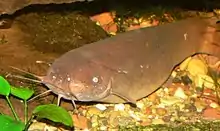Electric catfish
Electric catfish or Malapteruridae is a family of catfishes (order Siluriformes). This family includes two genera, Malapterurus and Paradoxoglanis, with 21 species.[1] Several species of this family have the ability to produce an electric shock of up to 350 volts using electroplaques of an electric organ.[2] Electric catfish are found in tropical Africa and the Nile River.[3] Electric catfish are usually nocturnal and carnivorous.[2] Some species feed primarily on other fish, incapacitating their prey with electric discharges,[2] but others are generalist bottom foragers, feeding on things like invertebrates, fish eggs, and detritus.[4] The largest can grow to about 1.2 m (4 ft) long, but most species are far smaller.[5][6]
| Electric catfish | |
|---|---|
 | |
| Malapterurus electricus | |
| Scientific classification | |
| Kingdom: | Animalia |
| Phylum: | Chordata |
| Class: | Actinopterygii |
| Order: | Siluriformes |
| Superfamily: | Siluroidea |
| Family: | Malapteruridae Bleeker, 1858 |
| Genera | |
Description
The Malapteruridae are the only group of catfish with well-developed electrogenic organs; however, electroreceptive systems are widespread in catfishes.[7] The electrogenic organ is derived from anterior body musculature and lines the body cavity.[3] Electric catfish do not have dorsal fins or fin spines. They have three pairs of barbels (the nasal pair is absent).[3] The swim bladder has elongate posterior chambers, two chambers in Malapterurus and three in Paradoxoglanis.[3]
Malapterurus have been conditioned by means of reward to discharge on signal. As reported in the New York Times, April 2, 1967, a researcher, Dr. Frank J. Mandriota of City College, New York, conditioned an M. electricus to discharge on a light signal for a reward of live worms delivered automatically. This is the first conditioning that modified neither glandular nor muscular responses.
The largest can grow to about 1.2 m (4 ft) SL and 20 kg (44 lb).[2][3][5] Most Malapterurus and all Paradoxoglanis species are much smaller, reaching less than 30 cm (1 ft) long.[3][5][6]
Relationship to humans
The electric catfish of the Nile was well known to the ancient Egyptians.[8] The Egyptians reputedly used the electric shock from them when treating arthritis pain.[9] They would use only smaller fish, as a large fish may generate an electric shock from 300 to 400 volts. The Egyptians depicted the fish in their mural paintings and elsewhere;[8] the first known depiction of an electric catfish is on a slate palette of the predynastic Egyptian ruler Narmer about 3100 BC.[7]
An account of its electric properties was given by an Arab physician of the 12th century; then as now, the fish was known by the suggestive name of raad, abo el raash, el raad, or raash, which means "thunder"[8] (literally "trembler" or "shaker").
The shock of these catfish is used to stun prey and in defense. It is not known to be fatal to humans,[2] but large electric catfish can stun an adult person.[9] In small electric catfish the generated current is far less and only feels like a tingle to humans.[9]
References
| Wikimedia Commons has media related to Malapterurus electricus. |
- Ferraris, Carl J., Jr. (2007). "Checklist of catfishes, recent and fossil (Osteichthyes: Siluriformes), and catalogue of siluriform primary types" (PDF). Zootaxa. 1418: 1–628. Retrieved 2009-06-24.
- Ng, Heok Hee (2000). "Malapterurus electricus". Animal Diversity Web. Retrieved 2007-07-28.
- Nelson, Joseph S. (2006). Fishes of the World. John Wiley & Sons, Inc. ISBN 0-471-25031-7.
- Moelants, T. (2010). "Malapterurus microstoma". IUCN Red List of Threatened Species. 2010: e.T181680A7703373. doi:10.2305/IUCN.UK.2010-3.RLTS.T181680A7703373.en.
- Froese, Rainer and Pauly, Daniel, eds. (2017). Species of Malapterurus in FishBase. March 2017 version.
- Froese, Rainer and Pauly, Daniel, eds. (2017). Species of Paradoxoglanis in FishBase. March 2017 version.
- Howes, George J. (1985). "The phylogenetic relationships of the electric catfish family Malapteruridae (Teleostei: Siluroidei)". Journal of Natural History. 19: 37–67. doi:10.1080/00222938500770031.
- Boulenger, George Albert (1911). . In Chisholm, Hugh (ed.). Encyclopædia Britannica. 5 (11th ed.). Cambridge University Press. pp. 512–515.
- "Malapterurus electricus". ScotsCat. 3 April 2013. Retrieved 15 March 2017.